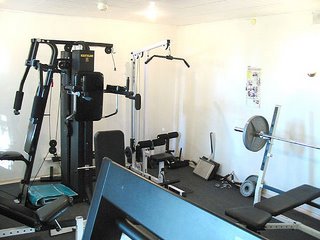The Six Rules of Building Strength
By Stephen Cox
October 29, 2008 • Fact checked by Dumb Little Man

Did you know that 50 to 70 percent of muscle gain (in terms of size) from body building style weightlifting is not actually muscle fiber at all? It’s actually a fluid called Sarcoplasm. As Sarcoplasm is a fluid and not muscle fiber it contributes very little to strength.
Many red-blooded men and women would like nothing more than to become stronger. The sense of achieving something of our human physical potential can be very fulfilling. Unfortunately modern bodybuilding has become a last refuge for lost souls with poor self-esteem and body image issues. This must at least be partly responsible for taking bodybuilding far from its original roots.
Bodybuilding has hugely influenced what people do at home and at the gym when they lift weights. Unfortunately bodybuilding has largely lost its way. It is now primarily just another arm of a profit driven “fitness” industry along with other sectors such as supplements and weight loss.
So today when we examine the following six rules of strength you may find that almost all the rules presented here are in direct contravention of commonly held body building “wisdom”. That’s because these rules are for iron athletes who want to become strong and be as strong as they look.
- Never go to failure
This is as good a place to start as any. A long held tenant of bodybuilding is that you should go to failure (lift until you cannot lift anymore). Take a turn around your local gym and you’ll see all types of people working out half reps and assisted reps that help push them into complete muscle failure.Compare this behavior to the massive size and strength of phenomenal powerlifters and Olympic weightlifters and know that they never go to failure. Nor does the greatest fighter on the planet Fedor Emelianenko. This is because training to failure is training to fail.
By not going to failure when he lifts, Fedor gets stronger while still remaining fresh enough to train fighting techniques. That means you can get a lot stronger without burning yourself out. No more feeling too exhausted post workout. No more feeling sore for three days after a workout.
- No more than five reps per set
Completing no more than five reps per set caries on from the idea of never going to failure. Figure out what your one rep max for a particular lift is and set the bar at around 70 to 80 percent it. Use that weight to do low rep sets of one to five reps. There is nothing wrong with doing heavy singles.Also, while perhaps counterintuitive, lifting heavy for sets of 1 to 5 reps is the safest way to lift. This is because the stabilizing muscles get tired before the prime movers in high rep sets, which sets you up for an injury.
- Lift heavy
If you want to get strong you have to lift heavy. This is dead simple. Sure, using light weights for high rep sets may give you some tone but doing so will never make you strong.Lifting heavy requires a large amount of tension. You will be forced to recruit muscle fibers in places not normally directly activated by the lift. Tension is strength. The greater the weight the greater the amount of tension required.
Think of strength as a skill. The more muscle fibers you can recruit to a movement and the harder the contraction of those muscle fibers the stronger you are. Lifting with heavy weights should be approached as practice as opposed to working out.
- Lift often
Many powerlifting and Olympic lifting teams work out as many as eight times per week or even more. This means they are working out more than once a day. They can do this because they are not going to failure and are working low rep sets. It has been found that completing five heavy singles per day for five days in a row is better for strength development than completing five sets of five reps on a single day.
- Take longer rest periods between sets
To avoid failure, you will need to take longer rests between sets. This will allow your body to adequately recover for the next heavy lift. You also will not experience anywhere near as much soreness post workout as a result of extending your rest periods.
- Focus on compound movements
Powerlifters and Olympic lifters do not train body parts. As discussed above with regards to tension, your body combined is far stronger than your body broken down by isolation exercises. Stick to lifts such as the deadlift, squat, benchpress, military press and the Olympic lifts – snatch and clean and jerk.
For more information check out Power to the People and Beyond Bodybuilding both by Pavel Tsatsouline and The Purposeful Primitive by Marty Gallagher. You can also read about the differences between bodybuilding and powerlifting explained in the articles Why Powerlifting and not Bodybuilding and Beginning Powerlifting.
Share your thoughts on these six rules of strength by leaving a comment. Also let us know what you have found works for you when it comes to increasing strength and becoming as strong as you look.
 |
Written on 10/29/2008 by Stephen Cox. Stephen learned the vital importance of good health the hard way. Having overcome open heart surgery at age 7, chronic fatigue at age 20 and debilitating migraines in between. Today Stephen writes daily at Balanced Existence where he shares the knowledge and insights gained from his personal journey of holistic health and wellbeing. | Photo Credit: eyeliam |

